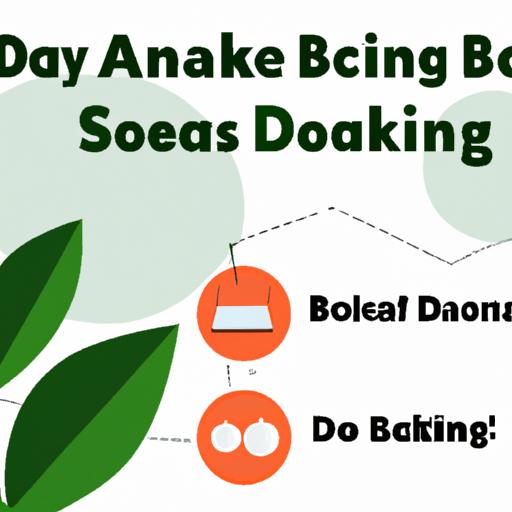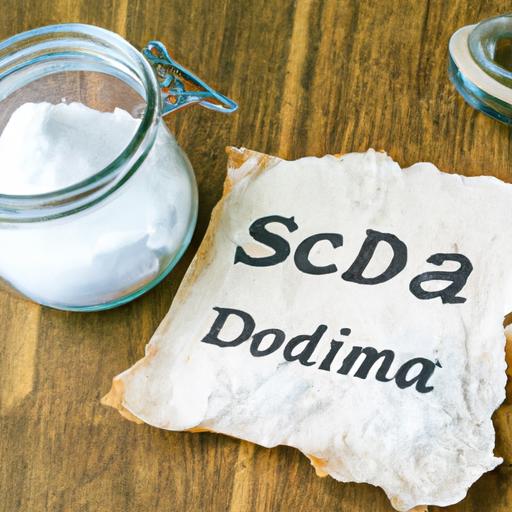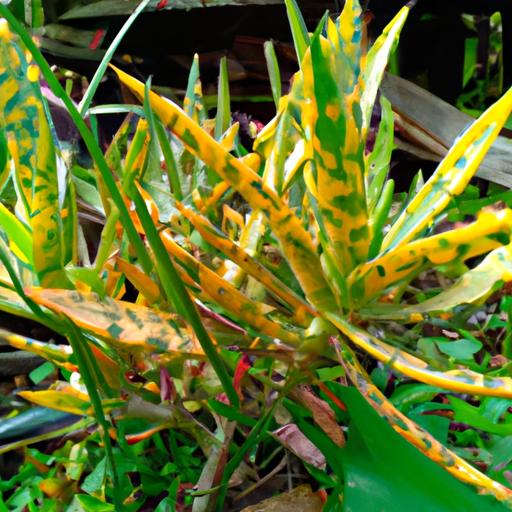Are you an avid gardener looking to give your plants a little extra boost? Have you heard about the benefits of using baking soda in gardening, but you’re not sure where to start? Look no further! In this article, we’ll delve into the world of baking soda and explore how it can help your plants thrive.
Introduction

As any seasoned gardener can tell you, maintaining a healthy garden takes a lot of work. From choosing the right plants to watering and fertilizing, there are many factors to consider. However, one often overlooked ingredient that can make a big difference is baking soda.
Baking soda, also known as sodium bicarbonate, is a white powder that can be found in most kitchens. While it’s often used in baking and cooking, it’s also a useful tool in gardening. Not only is it affordable and easy to find, but it can also benefit plants in a variety of ways.
In this article, we’ll explore the benefits of using baking soda in gardening, which plants benefit the most from its use, and how to incorporate it into your gardening routine. So let’s get started!
Understanding the Chemistry of Baking Soda

Baking soda has a unique chemical composition that makes it a valuable tool for gardeners. Here’s a breakdown of how it works:
Composition of Baking Soda
Baking soda, or sodium bicarbonate, is a compound made up of sodium, hydrogen, carbon, and oxygen. Its chemical formula is NaHCO3. When baking soda is added to water, it breaks down into sodium ions, bicarbonate ions, and water.
Baking Soda and Soil pH
Soil pH is a crucial factor in plant growth. Most plants prefer a slightly acidic soil pH between 6.0 and 7.0. However, some plants, such as blueberries, azaleas, and rhododendrons, prefer a more acidic soil pH between 4.5 and 5.5.
Baking soda can help raise the pH level of soil that is too acidic. When baking soda is added to soil, it reacts with the acid in the soil and releases carbon dioxide. This reaction neutralizes the acid, making the soil less acidic and more alkaline.
Baking Soda and Nutrient Uptake
Plants require nutrients to grow, and the availability of these nutrients depends on the soil pH. When soil is too acidic, certain nutrients, such as phosphorus, iron, and manganese, become less available to plants.
Baking soda can help improve the availability of these nutrients by raising the soil pH. As the soil becomes more alkaline, these nutrients become more soluble and available to plants. However, it’s essential to use baking soda in moderation, as too much can lead to an imbalance of nutrients.
Plants that Benefit from Baking Soda
If you’re wondering which plants can benefit from the use of baking soda, you’re in luck! Baking soda can be useful for a variety of plants, but some benefit more than others. Here’s a breakdown of which plants can benefit the most from baking soda use:
A. Overview of plants that prefer alkaline soil
Plants that prefer alkaline soil, with a pH level of 7.0 or higher, can benefit greatly from the use of baking soda. Some examples of these plants include:
-
Hydrangeas: These beautiful flowers thrive in alkaline soil and can produce vibrant blue blooms when the soil pH is around 6.0-6.2. Adding baking soda to the soil can help raise the pH level and produce those stunning blue flowers.
-
Sweet peas: These fragrant flowers also prefer alkaline soil, with a pH level of around 7.0-7.5. Baking soda can be added to the soil to help raise the pH level and promote healthy growth.
-
Broccoli: This vegetable prefers soil with a pH level of around 6.0-7.0. Adding baking soda to the soil can help keep the soil pH level in the desired range and promote healthy growth.
B. How baking soda can benefit plants that require neutral soil
Plants that require neutral soil, with a pH level of around 6.0-7.0, can also benefit from the use of baking soda. Some examples of these plants include:
-
Tomatoes: These popular garden plants prefer soil with a pH level of around 6.0-6.8. Adding baking soda to the soil can help keep the pH level within the desired range and promote healthy growth.
-
Peppers: Like tomatoes, peppers also prefer soil with a pH level of around 6.0-6.8. Baking soda can be added to the soil to help maintain the pH level and promote healthy growth.
C. Explanation of how baking soda can help plants combat fungal diseases
In addition to promoting healthy growth, baking soda can also help plants combat fungal diseases. This is because baking soda has antifungal properties that can help prevent the growth of certain fungSome examples of plants that can benefit from baking soda’s antifungal properties include:
-
Roses: These beloved flowers are often prone to fungal diseases such as black spot and powdery mildew. Adding baking soda to the soil around roses can help prevent these diseases from taking hold.
-
Cucumbers: Cucumbers are also prone to fungal diseases such as powdery mildew. Adding baking soda to the soil around cucumber plants can help prevent the growth of these fungi and promote healthy growth.
Overall, baking soda can benefit a wide variety of plants in your garden. Whether you’re looking to promote healthy growth or prevent fungal diseases, adding a little baking soda to your gardening routine can make a big difference.
How to Use Baking Soda in Your Garden
Now that you know the benefits of using baking soda in your garden, let’s dive into how to use it effectively. Here are some tips and precautions to keep in mind:
A. Tips on how to apply baking soda to the soil
When applying baking soda to your garden, it’s important to apply the right amount and at the right time. Here are some tips to help you get started:
- Use 1 teaspoon of baking soda per gallon of water for foliar spray.
- Mix 1 tablespoon of baking soda in 1 gallon of water and apply to the soil around plants as a soil drench.
- Apply baking soda early in the morning or late in the evening to avoid exposing your plants to direct sunlight.
- Test the pH level of your soil before applying baking soda to ensure that it’s necessary.
B. Precautions to take when applying baking soda
While baking soda is generally safe to use in gardening, there are a few precautions to keep in mind:
- Do not apply baking soda to plants that prefer acidic soil, as it can harm them.
- Avoid overuse of baking soda, as it can accumulate in the soil and lead to nutrient deficiencies.
- Always test the pH level of your soil before applying baking soda to avoid over-alkalizing.
C. Alternative methods of using baking soda in gardening
In addition to using baking soda as a soil amendment, there are other ways to incorporate it into your gardening routine. Here are a few alternative methods:
- Use baking soda as a natural fungicide to combat fungal diseases on plants. Mix 1 tablespoon of baking soda in 1 gallon of water and spray on plants.
- Add baking soda to your compost pile to speed up the decomposition process.
- Use baking soda to clean garden tools and equipment. Mix 1/4 cup of baking soda with 1 quart of warm water and use a sponge or brush to clean.
By following these tips and precautions, you can effectively use baking soda in your garden and reap the benefits for your plants.
Common Mistakes When Using Baking Soda in Gardening
While baking soda can be a valuable tool in your gardening arsenal, it’s important to use it correctly. Here are some common mistakes to avoid when using baking soda in gardening.
5.1: Common Myths Associated with Baking Soda in Gardening
There are many myths and misconceptions about the use of baking soda in gardening. One of the most common is that baking soda can be used as a natural insecticide. While baking soda can help control some pests, it’s not an effective insecticide on its own. Other myths include the belief that baking soda can cure all plant diseases or that it can replace fertilizer entirely. While baking soda can benefit plants in many ways, it’s important to understand its limitations and use it appropriately.
5.2: Common Mistakes to Avoid When Using Baking Soda in Gardening
One common mistake that gardeners make when using baking soda is applying it too frequently. While baking soda can help balance soil pH and combat fungal diseases, overuse can harm plants and disrupt the balance of soil nutrients. It’s important to follow recommended application rates and only use baking soda when needed.
Another mistake to avoid is applying baking soda to plants that don’t benefit from it. While some plants, such as tomatoes and peppers, benefit from alkaline soil, others prefer more acidic soil. Applying baking soda to plants that prefer acidic soil can harm them and reduce their yields.
5.3: How to Avoid Overusing Baking Soda in Gardening
To avoid overusing baking soda, it’s important to start with a soil test to determine the pH level of your soil. If your soil is already alkaline, applying baking soda can make it too alkaline and harm your plants. If your soil is neutral or slightly acidic, applying baking soda can help balance the pH and benefit your plants.
It’s also important to follow recommended application rates and only use baking soda as needed. Applying baking soda too frequently can harm your plants and disrupt the balance of soil nutrients. By using baking soda appropriately and avoiding common mistakes, you can help your plants thrive and achieve a healthy, vibrant garden.
Conclusion
As we’ve explored in this article, baking soda can be a valuable tool for any gardener looking to give their plants a little extra boost. From adjusting soil pH levels to fighting fungal diseases, its benefits are numerous.
By understanding the chemistry behind baking soda and knowing which plants benefit the most from its use, you can incorporate it into your gardening routine and see the results for yourself. Just remember to follow the proper application techniques and avoid common mistakes to ensure the best possible outcome.
In conclusion, if you’re looking for a natural, affordable way to improve the health and vitality of your plants, give baking soda a try. Your garden (and your plants) will thank you!



